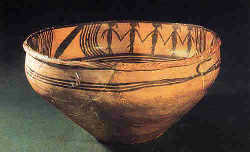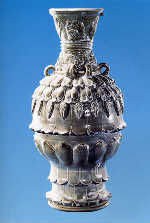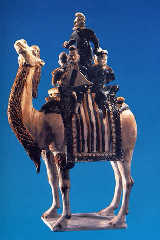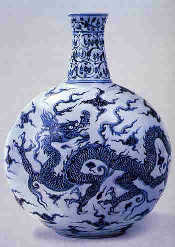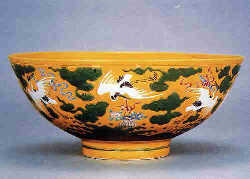| Art Q&A > Crafts |
|
|
The Wonderful World of Ceramics
Ceramics, the general art of heating common clay to create ornamental objects like pottery and porcelain, which is derived from pottery. The history of Chinese ceramics dates back some 8,000 years with the crafting of hand-molded earthenware vessels. Chinese primitive tribes began making artifacts with clay as early as 8,000 years ago. The Yangshao Culture was noted for its distinctive pottery painted with flowers, fish, animals, human faces and geometric designs. Although the origin of porcelain techniques is unknown, it is believed that primitive porcelain ware emerged in the middle and lower reaches of the Yangtze River and the Yellow River during the Shang and Zhou dynasties (16th century ¡¡ 221BC). Real porcelain ware appeared during the Han Dynasty (206BC - AD220).
Celadon
porcelain, together with black porcelain, was mainly produced during the Han
The ceramic industry of the Song Dynasty (960-1279), the third most prosperous period of the Chinese feudal society, reached an unprecedented height. Porcelain kilns with vivid regional features had spread all over the country, forming the ¡°six kiln factions¡± and ¡°five famous kilns¡±. The ¡°six kiln factions¡± were the ding kiln faction, jun kiln faction, yaozhou kiln faction, cizhou kiln faction, longquan kiln faction and jingdezhen kiln faction. The ¡°five famous kilns¡± were the guan kiln, ru kiln, ge kiln, ding kiln and jun kiln.
The Yuan Dynasty (1271-1368) saw a continued rapid development of the ceramic industry. Blue and white porcelain, which emerged in the Tang and Song dynasties, reached its maturity. The porcelain capital Jingdezhen emerged, which was famous for its blue-and-white porcelain, red under-glazed porcelain and egg-white porcelain. Great achievements were made in the production of the colorant glaze. Prior to the Yuan Dynasty people had fewer color choices.
Chinese ceramic-making reached its artistic peak during the latter part of the 15th century (Ming Dynasty, 1368-1644), largely due to the discovery of a new glazing technique called "five-color porcelain". This new method stirred the imaginations of artists by allowing them to use many different colors on porcelain after it had been baked. Hence, more complicated pictures -- human figures, religious scenes and landscapes -- began to replace earlier themes of flowers and fish on porcelain.
The early Qing Dynasty (1644-1911) witnessed the peak of Chinese ceramic production, with all ceramic types radiating their influence worldwide.
In the process of ceramic development, different styles of different periods blossomed over the centuries.
Celadon, or qingci, of the Tang Dynasty, has a subtle, bluish-green glaze and ischaracterized by simple and elegant shapes. It was so popular that production continued at various kiln centers throughout China well into the succeeding dynasties, and was shipped as far as Egypt, Southeast Asia, Korea and
Japan.
Tri-color Tang Pottery, or Tang Sancai, of the Tang Dynasty was named after the bright yellow, green and white glazes that were applied to the earthenware body. They not only appeared in such traditional forms as bowls and vases, but also in the more exotic guises of camels and Central Asian travelers, testifying to the cultural influence of the Silk Road.
Blue-and-white Porcelain, first produced in the Yuan Dynasty, was baked at an extremely high temperature and characterized by the purity of its kaolin clay body. It reached its golden era in the Ming Dynasty, coming to represent the virtuosity of the Chinese potter.
Five-color Porcelain of the late Ming and early Qing dynasties was usually fully covered with colorful patterns. Colors included red, yellow, light and dark green, brown, aubergine and under-glazed blue. Actually, there were more than five colors.
Five-color
Porcelain
After the birth of New China in 1949, social stability led to the revival of the ceramic industry, regaining its previous glory and greater recognition both home and abroad.
|
||||||||||||
All rights reserved. Reproduction of text for non-commercial purposes is permitted provided that both the source and author are acknowledged and a notifying email is sent to us. |
||||||||||||
 |
